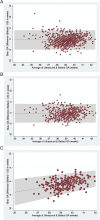Validity of Newborn Clinical Assessment to Determine Gestational Age in Bangladesh
- PMID: 27313070
- PMCID: PMC4925072
- DOI: 10.1542/peds.2015-3303
Validity of Newborn Clinical Assessment to Determine Gestational Age in Bangladesh
Abstract
Background: Gestational age (GA) is frequently unknown or inaccurate in pregnancies in low-income countries. Early identification of preterm infants may help link them to potentially life-saving interventions.
Methods: We conducted a validation study in a community-based birth cohort in rural Bangladesh. GA was determined by pregnancy ultrasound (<20 weeks). Community health workers conducted home visits (<72 hours) to assess physical/neuromuscular signs and measure anthropometrics. The distribution, agreement, and diagnostic accuracy of different clinical methods of GA assessment were determined compared with early ultrasound dating.
Results: In the live-born cohort (n = 1066), the mean ultrasound GA was 39.1 weeks (SD 2.0) and prevalence of preterm birth (<37 weeks) was 11.4%. Among assessed newborns (n = 710), the mean ultrasound GA was 39.3 weeks (SD 1.6) (8.3% preterm) and by Ballard scoring the mean GA was 38.9 weeks (SD 1.7) (12.9% preterm). The average bias of the Ballard was -0.4 weeks; however, 95% limits of agreement were wide (-4.7 to 4.0 weeks) and the accuracy for identifying preterm infants was low (sensitivity 16%, specificity 87%). Simplified methods for GA assessment had poor diagnostic accuracy for identifying preterm births (community health worker prematurity scorecard [sensitivity/specificity: 70%/27%]; Capurro [5%/96%]; Eregie [75%/58%]; Bhagwat [18%/87%], foot length <75 mm [64%/35%]; birth weight <2500 g [54%/82%]). Neonatal anthropometrics had poor to fair performance for classifying preterm infants (areas under the receiver operating curve 0.52-0.80).
Conclusions: Newborn clinical assessment of GA is challenging at the community level in low-resource settings. Anthropometrics are also inaccurate surrogate markers for GA in settings with high rates of fetal growth restriction.
Trial registration: ClinicalTrials.gov NCT01572532.
Copyright © 2016 by the American Academy of Pediatrics.
Conflict of interest statement
Figures




Comment in
-
What Matters Most for the Survival of Small Newborns in Resource-Limited Settings?Pediatrics. 2016 Jul;138(1):e20160734. doi: 10.1542/peds.2016-0734. Epub 2016 Jun 16. Pediatrics. 2016. PMID: 27313068 Free PMC article. No abstract available.
References
-
- Liu L, Johnson HL, Cousens S, et al. ; Child Health Epidemiology Reference Group of WHO and UNICEF . Global, regional, and national causes of child mortality: an updated systematic analysis for 2010 with time trends since 2000. Lancet. 2012;379(9832):2151–2161 - PubMed
-
- World Health Organization, The Partnership for Maternal, Newborn, and Child Health, Save the Children; March of Dimes . Born Too Soon: the Global Action Report on Preterm Birth. Geneva, Switzerland: World Health Organization; 2012
-
- Dubowitz LM, Dubowitz V, Goldberg C. Clinical assessment of gestational age in the newborn infant. J Pediatr. 1970;77(1):1–10 - PubMed
Publication types
MeSH terms
Associated data
Grants and funding
LinkOut - more resources
Full Text Sources
Other Literature Sources
Medical

